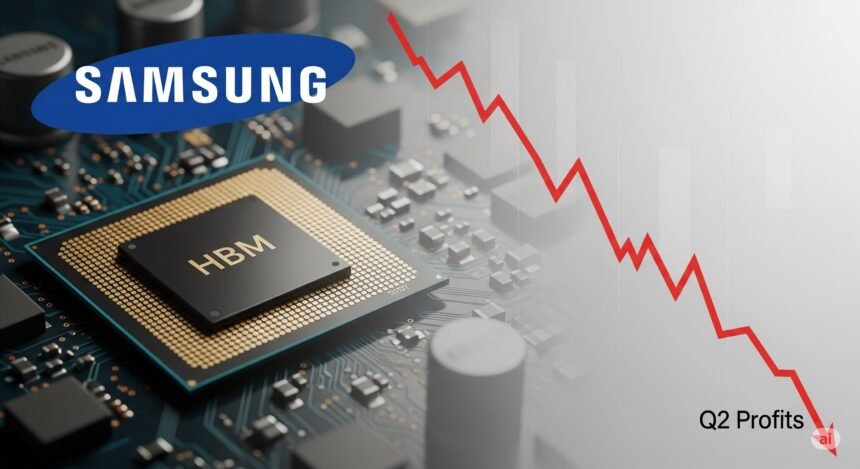SEOUL, July 7, 2025 — Samsung Electronics, the world’s leading memory chip maker and smartphone giant, is expected to report a dramatic 39% year‑on‑year decline in second‑quarter operating profit. According to analysts canvassed by LSEG SmartEstimate, earnings for the April-June quarter are forecast at just 6.3 trillion won ($4.62 billion), marking Samsung’s lowest quarterly operating profit in a year and a half.
Why AI Chip Sales Are Dragging Samsung Down
The primary reason behind the profit slump is a delay in shipments of advanced high‑bandwidth memory (HBM) chips to Nvidia, a leading global provider of AI chips.
Samsung had aimed to start supplying its latest HBM3E 12‑layer memory modules to Nvidia by June. However, certification delays have pushed back timelines, resulting in flat revenue in this key market for the quarter.
Analyst Ryu Young‑ho of NH Investment & Securities noted: “HBM revenue likely remained flat in the second quarter, as China sales restrictions persist and Samsung has yet to begin supplying its HBM3E 12‑high chips to Nvidia.”
Samsung began shipping HBM3E chips to AMD in June, but analysts say that still won’t have a significant revenue impact this year. Meanwhile, smaller rivals Micron and SK Hynix are ramping up faster and seeing stronger demand from AI data centre customers.
China Exposure + U.S. Export Limits = Hurdles
Ongoing U.S. technology export restrictions have weakened Samsung’s reliance on the Chinese market for revenue from advanced chips. These rules limit the sales of sophisticated memory products, such as HBM, to Chinese clients, further reducing revenue opportunities. In contrast, Micron and SK Hynix are less China‑dependent and are benefiting more from robust global demand for AI memory chips.
Additionally, uncertainties around U.S. trade policy loom large. The U.S. is considering revoking export authorizations for chipmakers like Samsung, which could complicate technology supply chains, especially those involving China-based plants.
Smartphone Unit Maintains Steady Growth
Not all Samsung businesses are under strain. Its smartphone division continues to show resilience, with solid sales momentum driven in part by early stocking ahead of possible U.S. tariffs, analysts say. Samsung is reportedly shipping aggressively to avoid any disruption should tariffs on imported phones be implemented.
This proactive strategy helped boost smartphone revenue in the first quarter. At the same time, Samsung’s consumer‐electronics and appliance businesses remain stable, cushioning the overall earnings fall.
Stock Market Reaction: Underperforming but Recovering
So far this year, Samsung has lagged behind broader market gains. Its shares have risen by roughly 19% in 2025, trailing the Korean KOSPI index’s 27% rally. On Monday morning, Samsung shares were down around 1.9% compared to a 0.3% rise in the broader index.
Investors remain cautious, though they’ve responded to any positive signs, such as early smartphone stocking and the start of HBM supply to AMD.
Samsung’s Chip Strategy?
Accelerating HBM Certification and Volume
Samsung must fast-track the approval of its HBM3E 12-high chips for Nvidia. Without this certification, shipments will remain limited, and profits will be suppressed.
Mitigating Export‑Restriction Risks
The company needs to diversify its memory-chip client base and potential production locations to minimize the impact of U.S. export controls targeting China-bound tech.
Reinvesting in AI‑Component R&D
Competitors such as SK Hynix and Micron are capitalizing on the growing demand for AI memory. Samsung may need to increase R&D spending, secure partnerships, or pursue technology acquisitions to stay competitive.
Broader Trade and Policy Risks
- Potential U.S. tariffs on smartphones and electronics remain a concern; although currently paused, they could resume as early as July 9 under reciprocal tariff rules.
- A looming decision by U.S. tech regulators to revoke export authorizations for non-U.S. chipmakers could threaten global supply chain markets.
Recovery Depends on HBM Push
Samsung’s current downturn is a result of its inability to match the momentum in the AI-memory market set by its rivals. But the company holds strong fundamentals:
- A global machine-learning and data-centre boom continues to drive demand for memory chips.
- Samsung has already begun delivering HBM3E to AMD.
- Smartphone and consumer‑electronics segments remain robust.
If Samsung can rapidly scale the certification and volume of its new HBM offerings, especially to Nvidia, it could regain its momentum by late 2025 or early 2026.
Samsung’s expected 39% drop in Q2 operating profit reflects broader struggles in the AI-chip business, primarily driven by delayed certification and limited sales of its advanced memory technology to Nvidia and China. Meanwhile, its smartphone units remain firm, shielding the group from what could have been a harsher slump. The next few quarters will test Samsung’s ability to accelerate its HBM rollout and navigate the shifting dynamics of U.S.-China trade.
Investors will be closely watching Samsung’s full Q2 earnings release (likely in late July) and any remarks on HBM3E chip approval, export restrictions developments, and progress in mitigating trade‑war headwinds.






